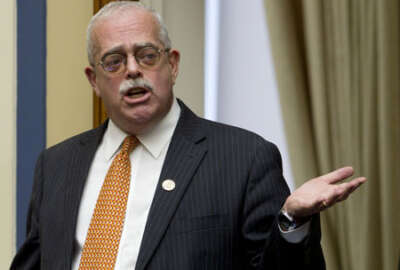

Investments in building a digital government have paid dividends for some agencies, and some have sought to expedite modernization projects through funding in t...
As the coronavirus puts a toll on public health and the economy, the demand for information during the pandemic has strained agency websites and the employees who run them.
Webpages run by the IRS, the Postal Service, and the National Institutes of Health make up just a few of the dot-gov sites that saw hundreds of millions of visits over the last month.
Amid this surge in traffic, investments in digital government have paid dividends for some agencies, and some have sought to expedite modernization projects through funding in the CARES Act.
Meanwhile, House Democrats continue to press for $1 billion for the Technology Modernization Fund to further bankroll these modernization projects.
During the pandemic, the Labor Department has rolled out digital certifications, multiple agencies have onboarded new employees virtually, and in-person visits to the Department of Veterans Affairs and Social Security Administration appointments have moved to videoconference platforms.
Federal Chief Information Officer Suzette Kent, speaking Thursday at Adobe’s virtual digital government symposium, said these examples were already part of the government modernization roadmap, but have rapidly scaled in response to the pandemic.
“In crisis, one often has new clarity about what is important and what’s most needed, and the national response to COVID-19 required that agencies continue to support mission continuity but also be incredibly nimble and aggressive in how they responded,” Kent said.
The 21st Century Integrated Digital Experience Act (IDEA), which President Donald Trump signed into law at the end of 2018, has set the bar for most agencies’ modernization strategies, and places a premium on digitized forms and electronic signatures.
In complying with the digital government legislation, the Energy Department has digitized two public-facing forms and implemented electronic signatures in phase one of an ongoing pilot.
The agency, now in phase two of the pilot, looks to digitize 200 forms.
DoE’s Deputy CIO Pam Isom, speaking at the Adobe conference, said the agency will see cost savings and a reduction in paper from this modernization, as well as an improved Section 508 compliance.
The agency website, she said, gets more than 26 million visits per month.
DOE moved forward with e-signature and digital forms through its Innovation Community Center, a digital “sandbox” where the CIO’s office, the agency’s national labs and its chief human capital officer collaborate on rapid prototype solutions.
The center, Isom said, not only meets the goals of 21st Century IDEA, but also modernizes the agency in ways that make it easier to meet its mission
“We started small with the Innovation Community Center with proofs of concepts and pilots, and as we start to apply the capabilities, we then extend across the department in increments, adding more and more users driving that digital transformation,” Isom said. “The outcome is no doubt mission value.”
As the agency moves further into phase two, Isom said the agency will track improvements in the customer experience through real-time data.
Through CARES Act funding, the Justice Department has also expedited the launch of a grants database that will allow officials to sign off via electronic signatures.
The General Services Administration has also adopted electronic signatures, and its Public Buildings Service has launched an electronic lease platform that allows the agency to e-sign and accept facility leases.
While the Social Security Administration has been under pressure for not yet rolling out electronic signatures, the agency, which handles Medicare Part B enrollment applications on behalf of the Centers for Medicare and Medicaid Services, is launching an online form to digitize what has been a completely paper-based process.
“You either walk it into a field office, you fax it in or you mail it in, but ultimately there’s going to be paper involved, David Ellison, SSA’s lead for digital transformation, said last Friday in an ACT-IAC webinar. “Right now, that isn’t happening, with the exception of some fax traffic that we’re picking up.”
With the pandemic disrupting paper processes, Ellison said SSA is quickly putting together an online form that with have anti-spam CAPTCHA features built-in.
“It’s not like the old ones, where you look at a grid and you have to pick out the bicycles, and if you get it all wrong, and you have to do it again. With the modern versions, that’s all done in the background,” he said.
By pushing its anti-fraud measures to the background, Ellison said SSA strikes a balance between providing a straightforward, easy-to-navigate experience for the public, but still keeping fraud measures in place.
“If someone is misrepresenting themselves, we have a lot of data, like the phone number they’re calling in with. If that’s mismatching with something that we have stored in our back-end systems, because we have a relationship with this citizen, we can steer that caller to someone who maybe is going to handle a fraud scenario, but we want to do it more in the background. We don’t want to expose all the citizens to an uncomfortable experience,” Ellison said. “We’re very lucky right now that these platforms are evolving to collect all this data and to be able to pass it along to our back-end fraud systems.
While 21st Century IDEA requires agencies to improve their digital services, Justin Herman, the former head of GSA’s Emerging Citizen Technology office, now the global head of public sector at Twilio, said the recent trend of improving digital services in government started with agencies like the Labor Department’s Office of Disability Employment and Policy.
“For years, when we would look at who was the first to really take a look at omnichannel experiences in government, a lot of it was the accessibility community. Not because it was the shiny new object, or it was the coolest thing to have, but because of the simple mission need — that many of the means of communication deployed by the government were not suiting the needs of our most vulnerable populations,” Herman said.
Building off best practices in accessible design, agencies in recent years have moved toward a “no wrong door approach” to customer experience, which puts less of a burden on users finding the right link on the right website.
“Whether you use a chatbot, whether you use a web form, where you use social [media], no matter what channel of communication the user needs, all of that is handled through the same system and made equally actionable and digestible for operations,” Herman said.
More than three years ago, the GSA launched the first government-wide pilot for chatbots, and since then, its Chief Financial Officer has led the charge on robotic process automation in government.
But as far as what will make the biggest impact on digital services in government, Herman said policies like 21st Century IDEA and Office of Management and Budget’s guidance on harnessing technology to support mission continuity during the pandemic will have a greater net benefit than some of the buzzier trends.
“A greater level of par is going to be created, where it’s not just going to be some agencies that are reaping the benefits of cloud communications or the omnichannel solution that should be available, but these become more standard,” he said.
Copyright © 2024 Federal News Network. All rights reserved. This website is not intended for users located within the European Economic Area.
Jory Heckman is a reporter at Federal News Network covering U.S. Postal Service, IRS, big data and technology issues.
Follow @jheckmanWFED



